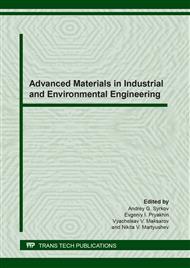[1]
M. Yu. Nazarenko, N. K. Kondrasheva, S. N. Saltykova, Sorption properties of fuel shale and spent shale, Coke and Chemistry, 60(2) (2018) 86–89.
DOI: 10.3103/s1068364x17020053
Google Scholar
[2]
Q. Wang, J. Bai, J. Ge, Y.Z. Wie, S. Li, Geochemistry of rare earth and other trace elements in Chinese oil shale, Oil shale, 31(3) (2014) 266–277.
DOI: 10.3176/oil.2014.3.06
Google Scholar
[3]
A.M. Gerasimov, A.M. Syroezhko, S.V. Dronov, V.M. Strakhov, Influence of shale's mineral composition on its thermochemical processing with asphal, Coke and Chemistry, 55(4) (2012) 150–154.
DOI: 10.3103/s1068364x12040035
Google Scholar
[4]
T. Pinu, A. Konist, E. Puura, M. Liira, K. Kirsimae, Properties and environmental impact of oil shale ash landfills, Oil shale, 36(2) (2019) 257–270.
DOI: 10.3176/oil.2019.2.01
Google Scholar
[5]
A.A. Aliyev, O.R. Abbasov, A.M. Agayev, Mineralogy and geochemistry of oil shale in Azerbaijan: classification, palaeoweathering and maturity features, Bulletin of V. N. Karazin Kharkiv National University, Geology. Geography. Ecology series 50 (2019) 11–21.
DOI: 10.26565/2410-7360-2019-50-01
Google Scholar
[6]
A. M. Syroezhko, D. Oyunbold, N. V. Slavoshevskaya, V. M. Strakhov, Influence of coal, shale, and petrochemical binders and fillers on the properties of cold-rammed hearth mass, Coke and Chemistry, 53(6) (2010) 222–227.
DOI: 10.3103/s1068364x10060050
Google Scholar
[7]
X. Li, Z. Wang, J. He, L. Hao, S. Li, W. Lin, Study on the composition characteristic of oil shale and its semicoke by using a thermobalance and a drop – tube furnace, Oil shale 36(2) (2019) 271–284.
DOI: 10.3176/oil.2019.2.02
Google Scholar
[8]
A.N. Shabarov, I.V. Nikolaeva, Integrated use of waste from thermal power plants, Journal of Mining institute, 220 (2016) 607–610.
Google Scholar
[9]
D.A. Zimina, R.Y. Kuznetsov, Development of cement composition with enhanced properties with the addition of microsilica, in: Youth Technical Sessions Proceedings: VI Youth Forum of the World Petroleum Council – Future Leaders Forum (WPF 2019), Saint Petersburg Mining University, Taylor and Francis Group, London, UK, 2019, p.399–404.
DOI: 10.1201/9780429327070-56
Google Scholar
[10]
I. Külaots, J.L. Goldfarb, E.M. Suuberg, Characterization of Chinese, American and Estonian oil shale semicokes and their sorptive potential, Fuel, 89(11) (2010) 3300–3306.
DOI: 10.1016/j.fuel.2010.05.025
Google Scholar
[11]
A.I. Alekseev, O.S. Zubkova, O.O. Kononchuk, Influence of the development of the mineral resources sector of the Arkhangelsk region on the environment, in: Innovation-Based Development of the Mineral Resources Sector: Challenges and Prospects – 11th conference of the Russian-German Raw Materials, 2018, p.437–447.
DOI: 10.1201/9780429022388
Google Scholar
[12]
A.A. Vinogradova, M.O. Silivanov, S.M. Leontyuk, Selection of method and means of measuring resonant frequency of serial oscillatory circuit, Journal of Physics: Conference Series, 1118(1) (2018) 012049.
DOI: 10.1088/1742-6596/1118/1/012049
Google Scholar
[13]
L. Bityukova, R. Motler, Composition of oil shale ashes from pulverized firing and circulating fluidized-bed boiler in Narva thermal power plants, Oil shale, 27(4) (2010) 339–353.
DOI: 10.3176/oil.2010.4.07
Google Scholar
[14]
M. Yu. Nazarenko, N.K. Kondrasheva, S.N. Saltykova, Surface reactivity of fuel shales from the Baltic basin, Coke and Chemistry, 59(5) (2016) 196–199.
DOI: 10.3103/s1068364x16050045
Google Scholar
[15]
M.Yu. Nazarenko, N. K. Kondrasheva, S. N. Saltykova, The characteristic of waste of oil shale processing for use as filtering materials, Water and Ecology, 1 (2018) 9–16.
DOI: 10.23968/2305-3488.2018.23.1.9-16
Google Scholar


